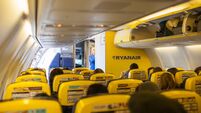Space shuttle Discovery rolled out to launch pad
Space shuttle Discovery completed a 10 1/2-hour trip to the launch pad at Cape Canaveral today after a brief delay caused by the discovery of a crack in the external fuel tank’s foam insulation.
Nasa later said the crack was no reason for concern.
The flaw was discovered yesterday as the spacecraft was being readied for the first shuttle launch since Columbia fell to pieces two years ago – a disaster blamed on a chunk of foam that fell off the tank during lift-off and gashed one of the wings.
Nasa spokeswoman Jessica Rye described the flaw as a hairline crack and said that after sending images of it to the tank’s manufacturer in Louisiana, the space agency concluded it did not need to make any repairs.
Nasa later said the 1 1/2 inch crack was high up on the shuttle in a spot where if foam flew off it would not likely hit the vehicle.
“It’s a very, very tiny crack. Very, very narrow ... well within our experience base,” said Mike Leinbach, shuttle launch director. “It was an acceptable condition for flight, so we rolled on out and we’re going to fly with it just as it is.”
Nasa then began moving Discovery from its assembly building to the launch pad, after a delay of at least two hours.
Because of Columbia’s disintegration over Texas in 2003 – and the deaths of all seven astronauts aboard – the tank has been extensively redesigned for Discovery’s flight.
Nasa plans a mid-May lift-off from Florida with a launch window from mid-May to June – a period dictated by the position of the international space station, the shuttle’s destination.
Discovery was moved on a 5.5 million pound transporter, a huge platform on caterpillar tracks, along a specially built road that is almost as wide as an eight-lane motorway. The 4.2-mile journey to the launch pad took 10 1/2 hours since the transporter moved at only one mph and encountered a minor snag at the end.
“It’s a great sight to see Discovery rolling out to the launch pad,” shuttle commander Eileen Collins, who will lead the crew on the next mission, said from Mission Control in Houston. “We know we are getting close.”














